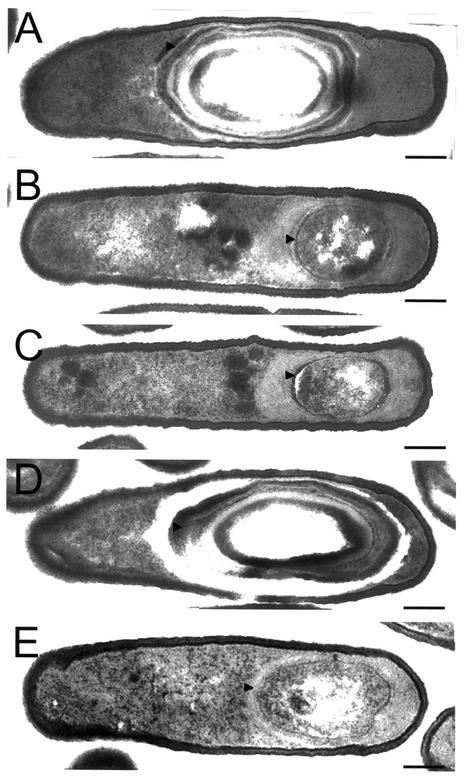FIG. 4.
Electron microscopy of the wild type and the spoIIIJ mutants. The strains were grown in DSM, and samples were taken 12 h after the onset of sporulation and processed for electron microscopy analysis as described in Materials and Methods. (A) Strain AH5011 (spoIIIJ expressed under the control of the spoIIIJ promoter at amyE); (B) JOB44 (spoIIIJ::km); (C) AH5025 (spoIIIJ::km/spoIIIGE155K); (D) AH5012 (spoIIIJ expressed under the control of the spoIIQ promoter at amyE); (E) AH5013 (spoIIIJ expressed under the control of the spoIID promoter at amyE). Strain AH5011 (PspoIIIJ-spoIIIJ) is shown instead of the wild-type MB24 to allow comparison with strains expressing spoIIIJ from the spoIID or spoIIIJ promoter. AH5011 sporulates with wild-type incidence (Table 3) and is indistinguishable from MB24 by electron microscopy (not shown). Both AH5011 (A) and AH5012 (D) form free mature spores like the wild-type MB24 but are represented at a stage prior to lysis of the mother cell to facilitate comparison with the sporulation mutants in panels B, C, and E. Strain JOB44 (B) is blocked just after completion of the engulfment process, as previously reported for the spoIIIJ87 mutant (16). AH5025 (C) and AH5013 (E) are also blocked at the engulfment stage of sporulation. The arrowheads indicate the protective layers that surround the spore (A and D) or the prespore membranes (B, C, and E). Bars, 0.2 μm.

